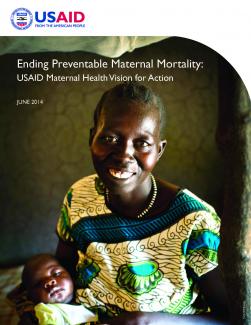The world has made impressive progress in reducing maternal mortality over the past two and a half decades. Despite this progress, 289,000 women worldwide still die each year as a result of pregnancy and childbirth. Most of these women live in poor nations, and the disparities are immense: the lifetime risk of maternal mortality for a woman living in sub-Saharan Africa is over 47 times greater than for a woman living in the United States. We know that most of these deaths are preventable. Women should not face unequal risks of death or disability due to pregnancy and childbearing, simply because of where they live. We possess the knowledge, tools, and resources to end this disparity. With a concerted effort from the international community and with strong political commitment, we can end preventable maternal deaths within a generation.
Ending Preventable Maternal Mortality (EPMM), now an internationally accepted goal, reflects a convergence of rich and poor nations focused on reducing maternal deaths. Our goal is to reduce the maternal mortality ratio (MMR) to a global average of less than 70 per 100,000 live births by 2030, and to < 50 per 100,000 live births by 2035.
In 2013, representatives from the World Health Organization and USAID proposed an ambitious but achievable goal in The Lancet Global Health to reduce the global average MMR to less than 50 per 100,000 live births by 2035. This level is the equivalent of the high end of Organization for Economic Cooperation and Development (OECD) countries in 2010.
Subsequent to The Lancet article, at an April, 2014 meeting hosted by the WHO, the Maternal Health Task Force, United Nations Population Fund, USAID and the Maternal and Child Health Integrated Program, representatives from 30 countries agreed on a 2030 global target MMR of less than 70 per 100,000 live births, with no country level greater than 140. The 2030 target places the world on a trajectory toward 2035 and the convergence of rich and poor nations for risk of maternal death. Achieving these goals would effectively end preventable maternal mortality.
USAID has been a leading voice in the growing global consensus to end preventable maternal mortality. Optimizing maternal health and promoting female empowerment and gender equality are fundamental to achieving our mission: partnering to end extreme poverty and promote resilient, democratic societies while advancing our security and prosperity. Millions of women around the globe still do not receive the family planning and maternal health care they need to survive and thrive. We envision a world where no woman dies from preventable maternal causes, and maternal and fetal health are improved. Because of the beneficial impact that increased attention and care for childbearing women has on child survival, our efforts to end preventable maternal death will also contribute to the end of preventable newborn and child death.
The Vision for Action for Ending Preventable Maternal Mortality endorses an integrated, comprehensive, and holistic approach to improve maternal and fetal health at the country level. Emphasis is placed on equity, respect for women and convergence of countries in reducing disparities in risk of maternal death.
The Vision outlines the strategic approaches, geographic areas of focus, and drivers which serve as a lens and guide for targeted, context-specific, country-based programming that will result in sustainable programs and improved maternal and fetal health. In partnership with a wide array of stakeholders, USAID will advocate rapid progress, promote public health through country ownership and international partnerships, build capacity for scale and sustainability, support innovation, seize opportunities to work collaboratively across disciplines and sectors, and invest in evidence and research to drive progress toward the goal. For USAID, ending preventable maternal mortality is a development challenge as well as a health challenge, and as a development agency, USAID has unique contributions to inform the global agenda to make the EPMM vision a reality.

